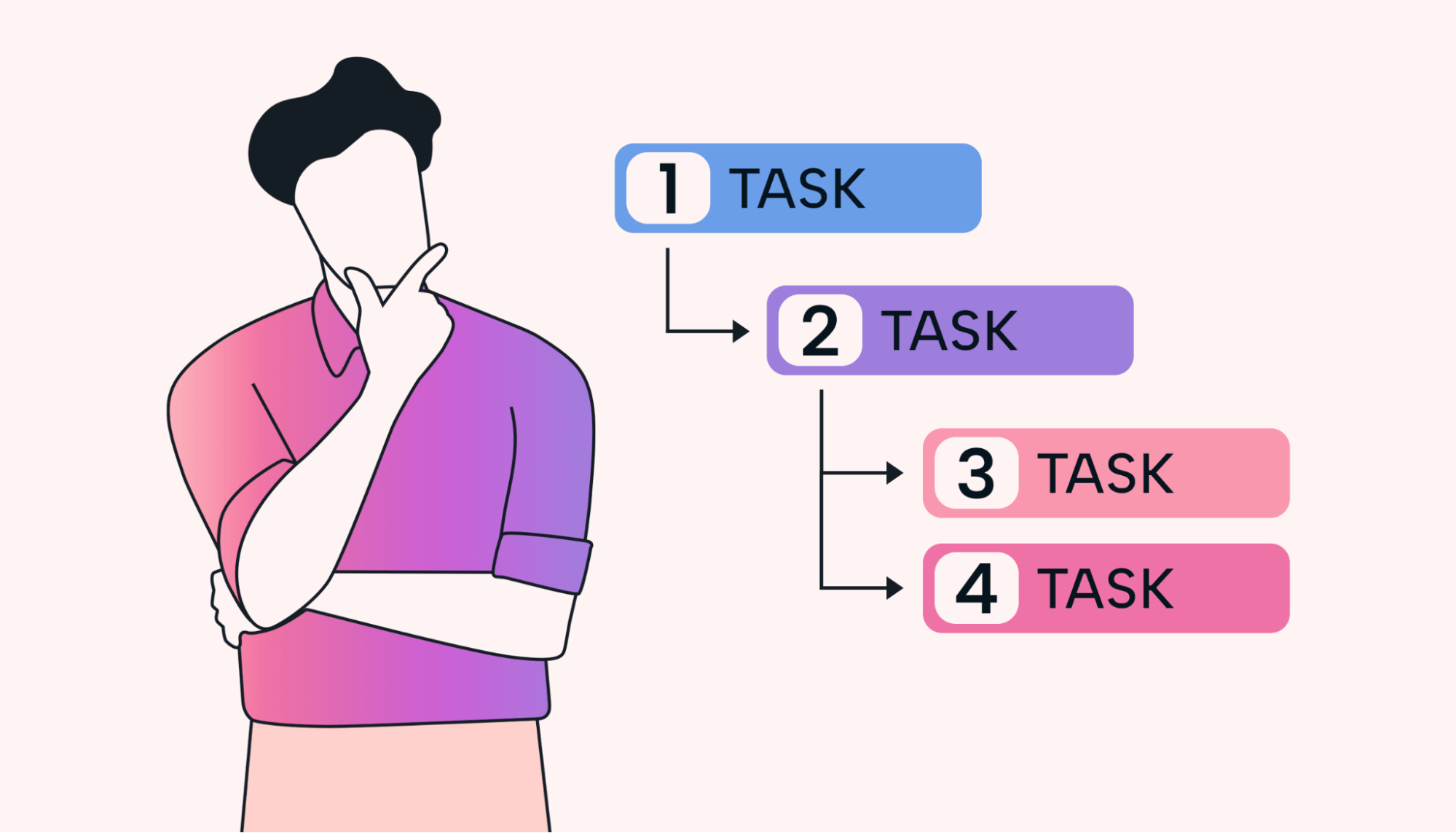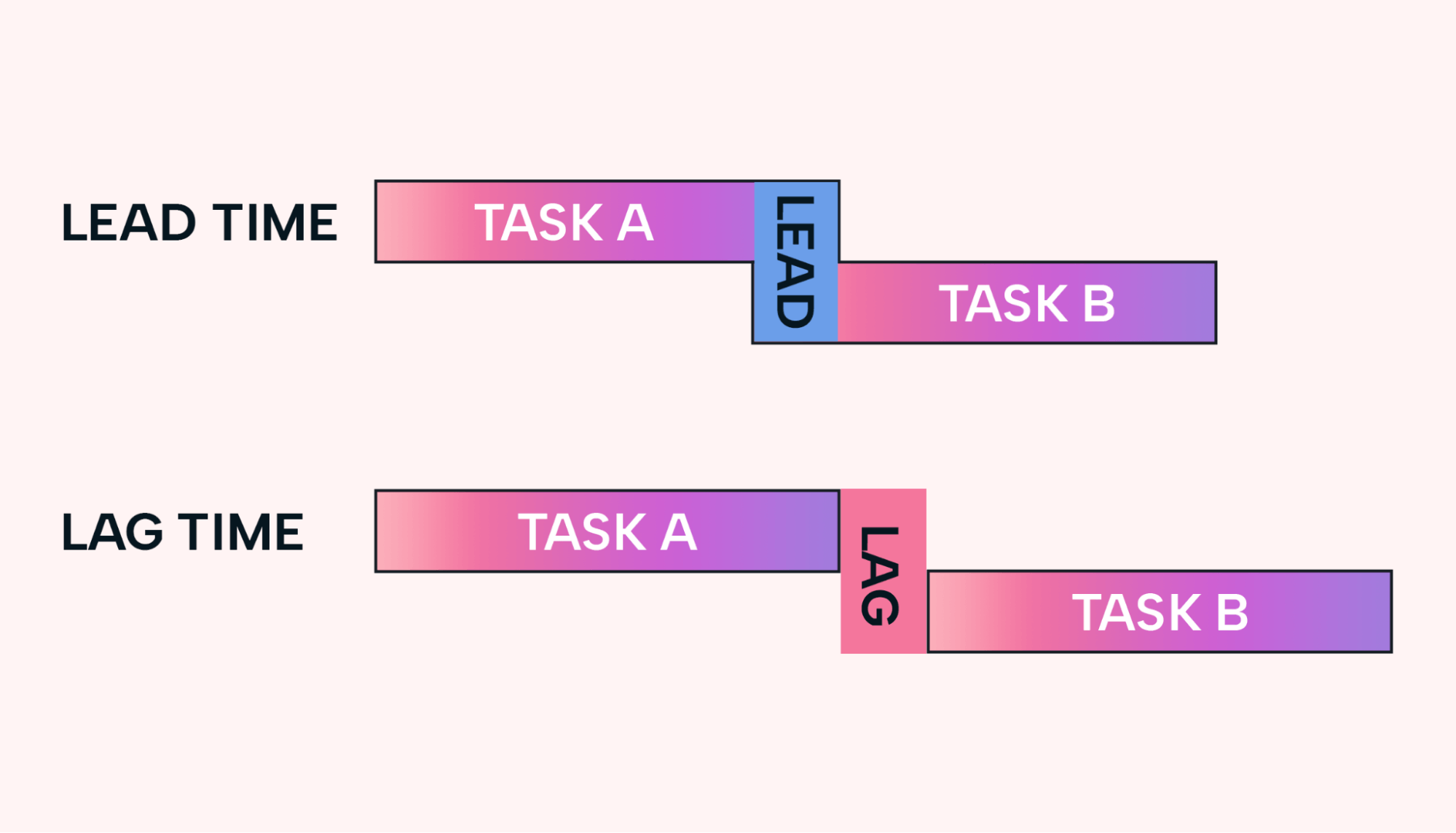There’s a common thread in business and projects: processes. In both cases, these processes are made up of a bunch of tasks. The problem is that a process is usually thought of as a list of tasks when, in fact, it’s more of a network of tasks.
The reason for this is what we call task dependencies. Some tasks need to be completed before others can be started. Other tasks must be performed at the same time. Still, other tasks must be completed by different teams. All of this requires tasks to be scheduled.
So yes, it can become very complicated if you try to keep track of all of it manually. This is why we often use project management software or tools to help us manage dependencies. And these days, many of these tools feature artificial intelligence (AI) technology to make it even easier for us.
Definition of task dependencies
Task dependencies in project management work exactly the same way as they do in business. What they’re really about is the relationships between different tasks. Which ones need to be finished first because their output becomes the input for other tasks?
While this might seem like a silly example, it does illustrate task dependencies clearly. On a production line that fills bottles with wine or oil, the cap can only go onto the bottle after the liquid has been poured into the bottle. That means the cap-affixing task is dependent on the bottle-filling one.
The goal of task dependencies is efficiency. It’s to prevent a stop-start workflow in a business or on a project. The process needs to run like a well-oiled machine.
Pros and cons of task dependencies
Whether you’re running a business or a project, task dependencies play a critical role because they establish the sequence and relationships between dependent tasks. But as with almost anything in our lives these days, there are pros and cons associated with using task dependencies.
Advantages
The key benefit of task dependencies is how they improve your planning process — for business ventures and for projects. They also help you minimize errors and increase transparency in task delegation.
That allows you to avoid scheduling conflicts and be more precise about the time you’ll need to build the business process or finish the project. Importantly, it also encourages accountability within your team and boosts morale by ensuring that everyone is on the same page.
 |
Disadvantages
Where task dependencies get tricky is in complex projects or business processes with a large number of dependent tasks. The result is limited flexibility and a need for constant monitoring to make sure no changes are needed to the plan.
Task dependencies can also become complicated when approvals involving external parties are required. That, too, can have a knock-on effect that can compromise the timeline. One defense is to rely on strong project management practices and get team agreement on timelines and responsibilities.
Of course, with AI-powered software such as Motion, these challenges can be overcome by the automated rescheduling of connected tasks. If you change your schedule in one place, all the necessary adjustments are cascaded through it instantly. Alerts to team members can also be triggered.
Types of task dependencies
There are four different types of dependency between tasks. And it’s by understanding these differences that you can plan and schedule your processes more effectively and efficiently. It doesn’t matter if you’re running a project or a business. These principles are equally valid in both environments.
1. Finish-to-start (FS)
The FS task dependency is the most common relationship between tasks. It simply means the successor task cannot start until the predecessor task is completed. For example, in the bottling plant example above, the task of filling a bottle must be finished before placing a cap on that bottle can begin.
Another example could be if you were making a YouTube video. One task is to shoot the video, and a dependent task is to edit that video. Obviously, the shooting must be finished before you can start the editing.
2. Start-to-finish (SF)
With an SF task dependency, the later task can only be finished once the previous one has started. It’s not a very common dependency relationship, but it does happen. Let’s say you’re implementing a new ERP system for your business.
The first process would then be to shut down the old system, and the second process would be to set up and begin processing on the new system. But you can’t shut down the old system until you’re ready to begin processing on the new one. That’s your SF relationship.
3. Start-to-start (SS)
This type of task dependency means that the successor task doesn’t have to wait for the predecessor task that it depends on to finish. It can start at any time after the other one has started. It also means that both tasks could start at the same time.
 |
Imagine you’re in the business of cladding the exteriors of old buildings to offer a more modern look to the world. You would begin to attach cladding at the ground level, but as you go higher, you’ll need scaffolding. The cladding could start first, and the erection of the scaffolding later, or the two processes could start together. That’s your SS task relationship.
4. Finish-to-finish (FF)
An FF task dependency is where the completion of one task depends on the completion of another. This means that while the work may be completed on the second task, it must wait in that state until the earlier task has also ended.
Let’s say that you’ve bought a new house, but you want to give the interior a lick of paint before you move in. Obviously, you’d have to paint and let it dry (the first task) before you move your furniture in (the second task).
Dependent tasks have a finish-to-finish dependency because you can run them (more or less) at the same time. You could paint one room, move onto another while the paint dries, and then go back to the first to move the furniture in. That’s an FF dependency.
The role of the manager or owner
Whether you're dealing with a business or a project, the role of the business owner and project manager remains critical. As the team leader, you are responsible for ensuring that all tasks are completed correctly, on time, and in the correct sequence.
Dependencies and teams
When you have a single team working on a business process or a project, it’s usually quite easy to keep track of your progress. However, it gets quite complicated when multiple teams are involved, as members of different teams may need to collaborate and coordinate their efforts.
This collaboration also helps them share resources such as equipment, software, or personnel. Completing a task by one team may rely on the task or resources of another team. This dependency could create a task relationship between the two teams, and any delays or issues in one team’s work can impact the other team’s ability to proceed.
Using leads and lags
One way you can embed some flexibility into your process is by using leads and lags. These allow you to create an overlap between dependent tasks in a chain and define waiting periods before a designated task can begin.
For example, if you have two tasks with an FS relationship. For whatever reason, you’d like a two-day delay between the finish of the predecessor task and the start of the successor task. Then, you’d insert a two-day lag between the tasks.
 |
A lead, on the other hand, is a way to speed up a project by allowing tasks to overlap. You could start the successor task before the predecessor task has finished.
Preferential dependency relationships
Task dependencies are usually based on chronological or logical task relationships. Preferential dependencies consider the preferences and priorities of team members and stakeholders, too. Skills, availability, workload, expectations, and resource allocations often influence them.
For example, your business or project may have a preferential dependency where a particular team member is required to complete a task before the next task can start. If that team member is in high demand, it may present challenges for your scheduling.
Alternatively, if a task needs input from or approval from an external stakeholder, that may delay the project and put the timeline at risk. But, it’s team-imposed, so this would be another preferential dependency.
Project schedules and task dependencies
The success of a business process or project relies heavily on understanding and managing task dependencies. And that, in turn, requires scheduling to determine the sequence, timing, and order in which tasks are executed.
Getting this right is the secret to ensuring you create a smooth workflow and timely delivery in your business or on your project. If you identify and manage your task dependencies effectively, you can optimize your scheduling, allocate resources efficiently, and minimize delays or bottlenecks.
Quite obviously, failing to do that could have the opposite effect.
Finding the right tools for you
Before technology became such a big part of our lives, business owners and project managers had to manage task dependencies manually. It was time-consuming and prone to error. And while the advent of spreadsheets helped a lot, errors still managed to creep in.
It was only with the advent of AI-powered project management software and tools that the error count began to drop significantly. This is why so many of Motion’s customers use our calendar and task scheduler to manage, organize, and prioritize their tasks.
No more clumsy to-do lists. No more stand-alone project management tools. A lot more work is getting done on time. Try Motion yourself with a 7-day free trial.






